Bulletin – April 2006 The Growth in Australia's Foreign Assets and Liabilities[1]
- Download 75KB
Introduction
The Australian economy is highly integrated into the world financial system, with Australians holding large amounts of foreign assets and foreigners holding a large amount of Australian assets (the liabilities of Australians to foreigners). Over the past 15 years, both foreign assets and liabilities have risen much more rapidly than GDP; Australians' holdings of foreign assets have more than doubled as a share of GDP, to over 70 per cent, while foreign holdings of Australian assets have risen from 70 to 130 per cent of GDP (Graph 1). Even though foreign assets are growing faster in percentage terms than foreign liabilities, the fact that the latter are much larger means that the margin by which liabilities exceed assets has increased over this period. This increase in net liabilities, however, has not been as rapid as might have been expected given the capital inflows associated with the funding of the current account deficit.
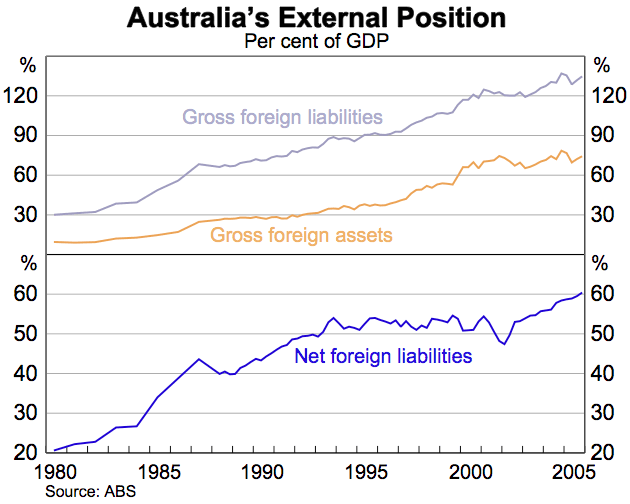
This article examines the main contributors to the increases in foreign assets and liabilities. It focuses both on the role played by capital flows and that played by valuation effects resulting from changes in asset prices and the exchange rate. The influence of hedging practices on the effect of exchange rate changes is also discussed.
The analysis demonstrates that capital flows have been the major influence on the evolution of Australia's external position, as would be expected for a country needing to finance a large current account deficit. More notably, however, the analysis suggests two further conclusions:
- First, valuation gains from asset-price changes – particularly the rise in the value of foreign equity assets – have provided an offsetting effect to capital flows. Australia's external assets are relatively skewed towards equities while liabilities are more skewed towards debt. As such, the valuation gains on assets in absolute terms on average exceed those on liabilities. One corollary of this is that the official measure of the current account deficit probably overstates the true ‘economic’ deficit, since the valuation gains are part of the overall return on foreign assets, but are not measured in the current account which includes only income flows.
- Second, the valuation effect of movements in the exchange rate on the stock of net foreign liabilities has changed notably over the past two decades, reflecting the changes in the composition of Australia's external position. In the mid 1980s, a depreciation of the exchange rate increased net foreign liabilities, as it increased the Australian dollar value of foreign liabilities by more than it increased the value of foreign assets. The reverse is true now, with a depreciation reducing net foreign liabilities, since Australia has significantly more foreign-currency-denominated assets than liabilities.
Gross Foreign Assets and Liabilities
The Australian dollar value of foreign assets or liabilities can change because of three factors:
- capital flows, as residents change their holdings of foreign assets or as foreigners change their holdings of Australian assets;
- changes in the value of the assets and liabilities due to changes in share prices and other financial prices; and
- changes in the exchange rate, as these affect the Australian dollar value of assets and liabilities denominated in foreign currency[2].
Graph 2 shows the contribution made by each of these three factors to the stocks of assets and liabilities over each of the past 15 years, while Table 1 summarises the total contributions over the period. The contributions are expressed as a percentage of nominal GDP to facilitate a comparison across time, as the absolute size of both assets and liabilities has increased substantially[3].
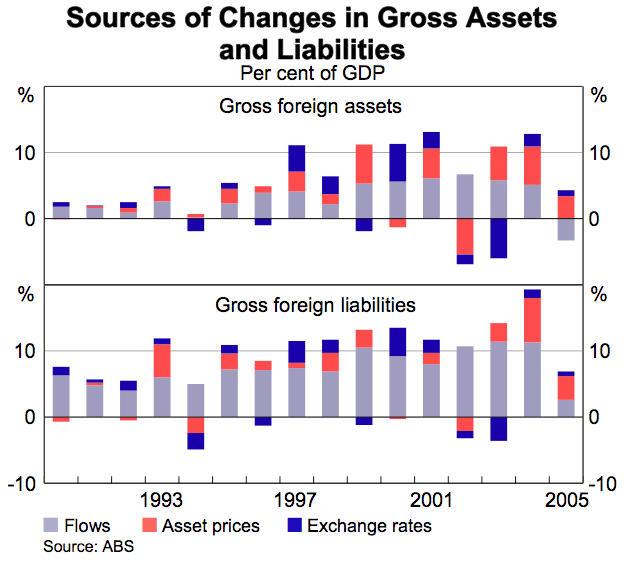
Not surprisingly, capital flows have generally made the largest contribution to the changes in the stock of both assets and liabilities. Reflecting the fact that Australia has been a net importer of capital throughout the period (as it has been throughout most of its history), flows have added more to the stock of liabilities than of assets. The size of both capital inflows and outflows has increased in absolute terms, reflecting the increase in global financial integration that has occurred over the period. Capital inflows in the form of debt have made the largest contribution to the increase in net foreign liabilities. While equity inflows have been relatively large at times, there has also been a marked rise in equity outflows in the form of Australian residents purchasing foreign equity. An important part of this has been offshore equity investment by superannuation funds. As a result, equity makes up a larger share of foreign assets than it does of liabilities (Table 2).
| Gross foreign assets | Gross foreign liabilities | Net foreign liabilities | ||
|---|---|---|---|---|
| Change due to: | ||||
| Capital flows | 3.2 | 7.4 | 4.2 | |
| Asset prices(a) | 1.8 | 1.5 | −0.3 | |
| Exchange rates | 0.5 | 0.6 | 0.1 | |
| Total change(b) | 5.7 | 9.6 | 3.9 | |
| Memo item: | ||||
| Current account deficit | 4.4 | |||
|
(a) Includes a small exchange rate effect as asset-price changes in foreign-currency-denominated
assets are converted into Australian dollars Source: ABS |
||||
| Foreign assets | Foreign liabilities | ||||
|---|---|---|---|---|---|
| Equity | Debt | Equity | Debt | ||
| 1990 | 14 | 13 | 24 | 46 | |
| 2005 | 41 | 31 | 50 | 79 | |
|
Source: ABS |
|||||
Asset-price changes have had a noticeable effect on the outstanding value of both assets and liabilities, but particularly the former. The primary source of movements in asset prices has been changes in equity prices. Holdings of bonds are much less affected by price movements, while loans and deposits are not affected at all. During the second half of the 1990s – a period where annual growth in global stock markets averaged 20 per cent – asset-price valuation effects increased foreign assets by an average of 2¾ per cent of GDP per year. Over the whole 15-year period covered by this analysis, capital gains have made a contribution to the growth of assets almost three-fifths as large as that of capital flows. Asset valuation effects have had a smaller impact on liabilities, not only in relative terms but also in absolute terms.
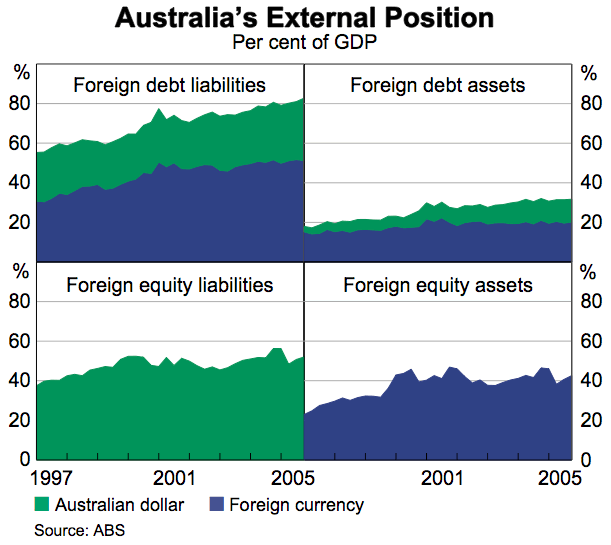
Exchange rate valuation effects have also had a significant impact on changes in foreign assets and liabilities at times over the past decade. The relative size of the influence of exchange rate changes on foreign liabilities compared with that on foreign assets is affected by their respective currency composition. Graph 3 shows that the stock of foreign equity liabilities is wholly denominated in Australian dollars and about one-third of foreign debt liabilities are in Australian dollars. The stock of foreign equity assets is denominated wholly in foreign currency as is the bulk of foreign debt assets held by Australians.
The biggest impact of the exchange rate on the value of foreign assets and liabilities was in the late 1990s, when the Australian dollar fell sharply. Between 1997 and 2001 exchange rate valuation effects boosted the stock of gross foreign assets by an average of 2¾ per cent of GDP per annum, and the stock of gross foreign liabilities by 2¼ per cent of GDP per annum – i.e. liabilities were affected less than assets. The subsequent appreciation of the Australian dollar reduced the value of foreign assets and liabilities in 2002 and 2003.
The valuation effect of exchange rate movements has changed noticeably over the past 20 years or so. In the mid 1980s, a 10 per cent depreciation of the exchange rate would have caused the stock of net foreign liabilities to increase by around 1 per cent of GDP. In 2005, a 10 per cent depreciation of the exchange rate would result in the stock of net foreign liabilities decreasing by 1¼ per cent of GDP. Between these two periods the increase in foreign currency assets significantly exceeded the increase in foreign currency liabilities. These figures are before account is taken of off-balance sheet hedging. As noted below, after allowing for hedging, the reduction in net liabilities resulting from a 10 per cent depreciation of the Australian dollar is closer to 3 per cent of GDP.
Any country which is able to borrow overseas in its own currency will tend to be in a position where a depreciation of its currency works to reduce its net foreign liabilities[4]. The United States is probably the most extreme case of this. Nearly all US foreign liabilities are denominated in US dollars, whereas the bulk of US foreign assets are denominated in foreign currency. Given this currency composition, a depreciation of the US dollar would substantially reduce the US dollar value of US net foreign liabilities, as the value of foreign liabilities would largely be unaffected but the US dollar value of foreign assets would rise[5]. In contrast, in a number of less-developed countries, foreign liabilities tend to be denominated predominantly in foreign currency. In those cases, a depreciation of the local currency will substantially increase the local currency value of net foreign liabilities.
The Impact of Hedging on Exchange Rate Valuation Effects
Australian firms undertake extensive hedging of their foreign currency liabilities and, to a lesser extent, their foreign currency assets. The Australian Bureau of Statistics (ABS) recently published results of a survey on the foreign exchange hedging practices of Australian firms. Information collected from the survey allows us to analyse the sensitivity of Australia's net foreign liabilities to exchange rate movements after taking into account off-balance sheet positions in financial derivatives. The survey showed that around 80 per cent of the foreign currency exposure on debt assets and liabilities was hedged back into local currency, while around 20 per cent of foreign equity assets were hedged back into Australian dollars. Table 3 shows the impact of a 10 per cent depreciation of the exchange rate on assets and liabilities, both with and without adjusting for hedging practices.
| Before accounting for hedging | After hedging | |||
|---|---|---|---|---|
| Actual | Assuming 10% depreciation |
Actual | Assuming 10% depreciation |
|
| Assets | ||||
| Foreign equity | ||||
| Australian dollar | 0 | 0 | 75 | 75 |
| Foreign currency | 360 | 400 | 285 | 316 |
| Foreign debt | ||||
| Australian dollars | 92 | 92 | 228 | 228 |
| Foreign currency | 173 | 193 | 37 | 41 |
| Total assets | 625 | 685 | 625 | 660 |
| Liabilities | ||||
| Foreign equity | ||||
| Australian dollar | 490 | 490 | 490 | 490 |
| Foreign currency | 0 | 0 | 0 | 0 |
| Foreign debt | ||||
| Australian dollars | 262 | 262 | 600 | 600 |
| Foreign currency | 428 | 476 | 90 | 100 |
| Total liabilities | 1,180 | 1,228 | 1,180 | 1,190 |
| Net foreign liabilities | 555 | 543 | 555 | 530 |
|
(a) Figures may not add due to rounding Sources: ABS Cat Nos 5302.0 and 5308.0; RBA |
||||
The table shows that the reduction in net foreign liabilities due to the depreciation of the Australian dollar is larger once hedging is taken into account. On the asset side, hedging acts to limit the gains from depreciation, as it shifts some foreign-currency equity assets back into Australian dollars. However, this effect is more than offset by the fact that hedging converts a much larger proportion of foreign-currency-denominated debt liabilities back into local currency terms. As a result, we estimate that after accounting for the currency composition of net foreign liabilities and off-balance sheet hedging, a 10 per cent exchange rate depreciation would decrease net foreign liabilities by around $25 billion (or 3 per cent of GDP). This is double the estimated change when hedging is not accounted for.
The effect of hedging is reflected in the valuation effects reported by the ABS in the official statistics. It appears as changes in the market value of the derivatives used to conduct the hedging. However, as discussed in more detail in Appendix A, care must be taken in interpreting the reported data on exchange rate valuation, because of the extensive use of hedging.
Net Foreign Liabilities
Looking at the sources of changes in the net foreign liability position, the conclusion is that capital inflows explain the general increase in net foreign liabilities since 1990, but asset-price effects overall have had an offsetting influence (Graph 4). The cumulative impact of exchange rate changes has been small, though there have been periods where it has been significant.
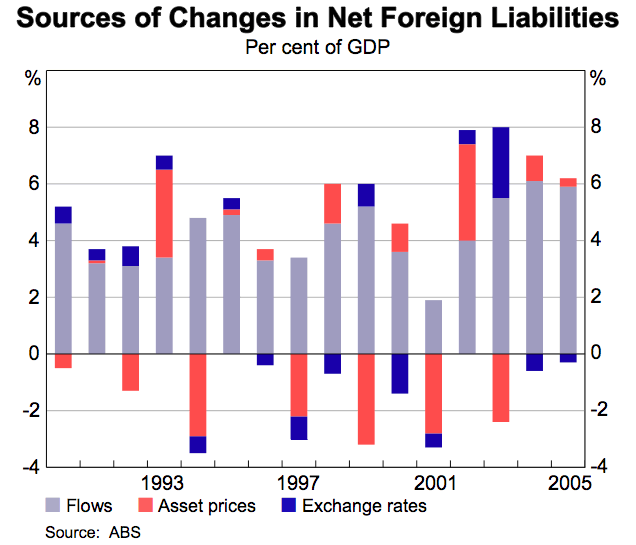
The effect of asset-price changes has been primarily because of equity price movements. The capital gains made on assets on average have been larger than those on liabilities, thereby working to reduce net foreign liabilities. This impact was greatest between 1997 and 2001, when strong gains in overseas share markets meant that asset-price effects reduced net foreign liabilities as a proportion of GDP by over 6 percentage points. Part of that was subsequently reversed in 2002 when the smaller downturn in the Australian share market compared with global markets caused asset-price valuation effects to increase net foreign liabilities. However, over the 15 years since 1990, asset-price gains reduced net liabilities by a cumulative 4 percentage points of GDP (Graph 5).
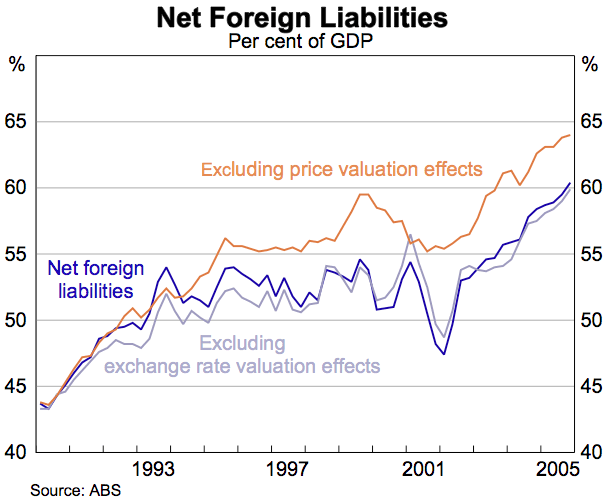
As noted, this outcome largely results from the fact that foreign assets are relatively skewed towards equities (which over time typically rise in value) while liabilities are mainly in debt, which tends to be more stable in value. It is, of course, also affected by the relative performance of Australian and overseas equity markets.
These figures have implications also for how the current account is measured. In the balance of payments statistics, returns on assets are separated into current and capital items. Returns on debt, which come mainly in the form of interest payments, are recorded in the current account. However, in the case of equities, a large part of the return is measured in the capital account, as only dividend payments are recorded in the current account. One result of this is that a country which holds its overseas assets in equities will, other things equal, record a larger net income and current account deficit compared with one which holds its overseas assets in the form of debt. In Australia's case, if we were to treat the net valuation gains on foreign assets as all being part of the ‘income’ from these investments and include them in the current account, the current account deficit would have been on average about 0.3 percentage points of GDP per year lower than was actually recorded over the 15-year period.
Conclusions
Capital flows have had the largest impact on the evolution of the stock of Australia's external position but valuation effects have also played an important, and offsetting, role. Over the past 15 years, asset-price changes, particularly those related to movements in equity prices, have reduced the stock of net foreign liabilities by around 4 percentage points of GDP compared with what it otherwise would have been. While the effect of exchange rate movements on the stock of gross debt and equity can be quite large at times, on balance it has been relatively small. However, the important fact about the effect of the exchange rate on the net liability position is that it has changed sign over the past two decades: twenty years ago, a depreciation of the exchange rate boosted Australia's net external liabilities, whereas now it would reduce net external liabilities.
Appendix A: Foreign Exchange Hedging and Valuation Effects
A significant part of Australia's foreign assets and liabilities that are denominated in foreign currency are hedged back into Australian dollars. This appendix summarises the treatment by the ABS of hedging in the statistics on Australia's external position and describes how this affects the assessment of exchange rate valuation effects.
The hedging instrument (such as a currency swap) is regarded by the ABS as a separate instrument from the foreign-currency-denominated asset or liability for which it is providing the hedge. Whether the hedging instrument has a positive or negative market value determines whether it is recorded by the ABS as an asset or liability.
Take for example a firm that uses a derivative to completely hedge the foreign currency exposure on a debt liability. If the exchange rate were to depreciate, the Australian dollar value of the debt liability would rise but the derivative would have an offsetting positive market value. This is not netted off the liability but is included as a foreign asset. In this case, an exchange rate movement will result in exchange rate valuation effects for both foreign debt assets (the change in the derivative's market value) and foreign debt liabilities (the change in the A$ value of the underlying debt instrument). The exchange rate valuation effects will therefore only be zero for net foreign debt (see Table A1). If the derivative has a negative market value (is out-of-the-money), it is recorded as a debt liability. In this instance, an exchange rate change will have no effect on the value of gross debt liabilities as the effect on the underlying debt and on the hedging instrument will cancel out.
| Pre-depreciation | Post-depreciation | Exchange rate valuation effect |
||
|---|---|---|---|---|
| Foreign currency debt assets | 0 | 11 | 11 | |
| Financial derivatives (buy FCY 100 million/ sell A$100 million) |
0 | 11 | 11 | |
| Foreign currency debt liabilities | −100 | −111 | −11 | |
| Debt (FCY 100 million) | −100 | −111 | −11 | |
| Net foreign currency debt | −100 | −100 | 0 | |
|
(a) Pre-depreciation we assume A$1 = 1 FCY (foreign currency unit). Post-depreciation we assume a fall to A$1 = 0.9 FCY. Figures are rounded to nearest A$1 million. Source: ABS |
||||
In the case where a derivative is used to hedge a foreign-currency-denominated equity holding, again the derivative will appear as a debt asset or liability depending whether it is in or out of the money, while the underlying equity investment will be recorded as a foreign equity asset.
This implies that one must be careful in interpreting the effect of exchange rate changes on the value of gross foreign assets and liabilities when a sizeable proportion of the assets and liabilities are hedged, as is the case in Australia. Exchange rate changes will affect the Australian dollar value of foreign-currency-denominated instruments as well as any hedging instrument associated with them. Examining the effect of an exchange rate change only on the stock of gross liabilities (say) ignores the fact that the value of gross assets may also be affected by a change in the value of hedging instruments associated with those liabilities.
Footnotes
This article was written by Market Analysis section, International Department. [1]
Given that the currency composition of foreign-currency-denominated assets and liabilities is similar, the nature of any change in the Australian dollar does not have a disproportionate impact on assets or liabilities. [2]
The stock of assets and liabilities expressed as a share of GDP will also be influenced by changes in the growth rate of nominal GDP. [3]
See IJ Macfarlane, ‘Some observations on recent economic developments’, <http://www.rba.gov.au/speeches/2005/sp-gov-131205.html>, for a discussion of foreign borrowing and hedging. [4]
See Pierre-Olivier Gourinchas and Hélène Rey (2005), ‘International financial adjustment’, NBER Working Paper No 11155. [5]